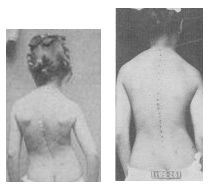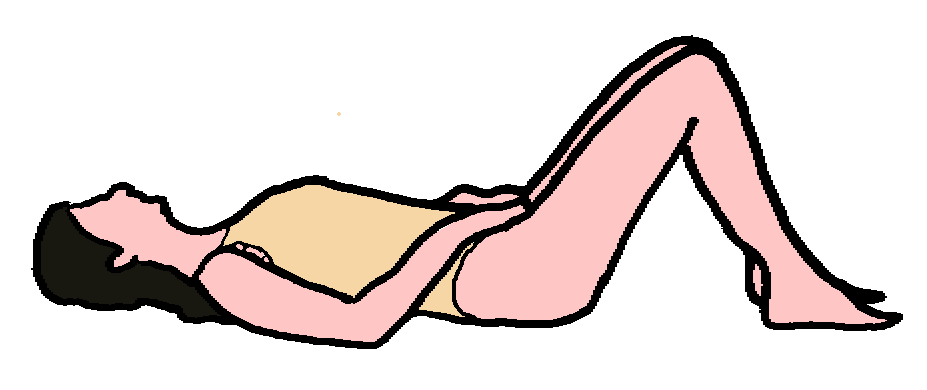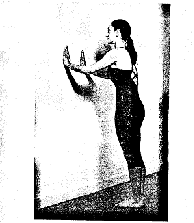The Joseph Pilates approach to Exercise, developed over a period of 100 years,
and predating as it does the miracles of modern
surgery, can certainly make a difference to Scoliosis....
Index, this page
Can Exercise "Straighten" Scoliosis?
Is Exercise Safe for People with Scoliosis?
The Pilates Approach to Straightening out a Scoliosis: "Work to the Center Line"
Make Straightening of Scoliosis easy for yourself and your client!
Wall Series Exercises for Scoliosis Straightening
Wall Series Exercises Lying Down for Scoliosis Straightening
Standing Arm Weight Exercises for Scoliosis Straightening
Standard Mat Exercises for Scoliosis Straightening
Excerpts from K Adamany, D Loigerot: The Pilates Edge
Sample Exercises from K Adamany, D Loigerot: The Pilates Edge
Postscript: "Pilates will help with your scoliosis...
Can Exercise "Straighten" Scoliosis?
Yes! - The Picture below shows that exercise can indeed make a difference. Further information:-
Connective Tissue Disorder Website

Is Exercise Safe for People with Scoliosis?
Basically, yes! - Read this article:-
National Scoliosis Foundation: Exercise, and Adults with Scoliosis
All the same, a Pilates instructor will recommend you to get medical clearance and will
also encourage you to seek physiotherapeutic advice when needed. He or she may also choose
to simplify or omit some of the Pilates Mat Exercises (for example, "Rolling Like a Ball" and the "Seal").
The Pilates Approach to Straightening out a Scoliosis: "Work to the Center Line"
In most Pilates exercises, we are told to "work to the center line".
Your center line runs through your spine, and down between your inner thighs all the way to the floor.
"Work to the center line" means "Keeping your body elongating
and symmetrical about the center line". Deceptively simple advice, but very powerful.
There are three basic Pilates exercise strategies for straightening a scoliosis:
- Lengthen the Center line. This will remove any components of kyphosis and lordosis associated with the spinal deformity.
- Visually develop symmetry around the center line by better positioning of body parts (requires that
that you look in the mirror or that an instructor with a good eye uses "hands on guidance").
- Use "body sense" (kinaesthesia) to develop symmetry around the center line by
feeling a difference between the sides as you exercise. If an exercise reveals a weakness
on one side, do 50% more repetitions on that side.
If a stretch reveals stiffness on one side, stretch it more.
- A fourth strategy, described and championed by Katherina Schroth, is that of "rotational breathing". This
is something that Pilates instructors can teach once "breathing into the back is established.
After this, it is a question of breathing into the concave (none gibbus) side of the scoliosis.
(More to be added at a later date).
(The rest of this article is written from the point of view of your Pilates instructor,
but it will still be of use to you).
Make Straightening of Scoliosis easy for yourself and your client!
The first steps are:-
- Teach the engagement of the powerhouse (Tansversus abdominis).
This requires abdominal scooping,
with "buttons 1 to 4" (and even a fifth button, a button at the lower end of the breast bone)
pulling the abdomen deeply toward the spine.
- Teach lateral breathing (breathing into the sides of the lower rib cage). This can only
happen when the abdominal scoop and hollow is mastered. A basic cueing for this would be:
"Scoop deep, (buttons 1 to 5),
and breathe into the sides of your rib cage and upper back".
(Note: Connection of the buttocks/inner thighs and the shoulder girdles to the powerhouse
has not yet been taught, and would need to be covered in a later lesson).
Once these first two steps are achieved, we can conform the back to the wall, and do some wall exercises
while working on straightening:-
(1) Wall Series Exercises for Scoliosis Straightening:
Note: the following section applies to scoliotic spines that also have kyphosis
and/or Lordosis (similar to the picture at the top of the page).
Teenage scoliotic spines tend not to have kyphosis - in fact quite the contrary! - their backs often
flatten easily against a wall.
Later in life, the older spine may well add kyphosis to the pre-existing scoliosis.
The following section applies to this "old age category". If it is easy for your client to
perform the following, then don't persist. It won't do harm, but you will
do better to devote your efforts to other parts of the program.
The wall series makes it easy for you to check that your student is "working to the center line".
The first step is to remove kyphosis and lordosis by conforming the spine to the wall:-
Get your student to press the full length of their spine into the wall.
This won't be easy, but diligent practice through the months and even years will pay dividends.
|
Diagrams: "conforming the spine to the wall". Left: A man with severe kyphosis (hump back), and
lordosis (curvature of the lower back). Middle: Positioning for wall series exercises.
Right: The ultimate in conforming the spine to the wall (picture reproduced from Brooke Silars:
The Pilates Body. See advert, this page).
|

|

|

|
While "conforming to the wall", you can get the client to perform the wall series
exercises and work on body symmetry (i.e. "working to the center line").
Look for one side of pelvis, shoulders or head being higher than the other;
use gentle hands on guidance and/or a "tapping touch" to encourage a body part either toward
your fingers or away from your fingers. That is a lot to think about all at once. But practice makes perfect.
The student can continue to work upon conforming to the wall and "straightening" with the use of a mirror at home.
(2) Wall Series Exercises Lying Down for Scoliosis Straightening:
The wall series may be too hard for your client, so make it easier for them! -
do the wall series arm
| exercises while lying down on the back with knees bent and feet
flat on the floor (Relaxation Position):
|

|
Gravity now helps the spine to press its full length into
the mat with the result that the whole body lengthens, and the scoliosis unravels slightly.
|
Wall series arm movements can be adapted to lying down: "Arms long overhead"
with abdominals deeply scooped and mid back pressed firmly into the mat
|

|
will teach awareness and correction of kyphosis/lordosis, and the student then
continues to practice holding the spine into the mat while completing the wall
series arm movements while lying down.
Bring deep breathing into the arm movements, making sure to "inhale into the
sides of the ribs and upper back", and to exhale fully and "funnel the lower ribs"
into the center line. At all times, keep spotting and using touch to encourage
the student toward the center line.
(3) Standing Arm Weight Exercises for Scoliosis Straightening
The standing arm weight series, especially side bends and "chest expansion",
when combined with correct deep breathing, and remembering to "lean into the
wind" will help "stretch" the rib cage and balance both shoulder girdles. Again,
watch closely, and use touch to encourage the student to "work to the center line".
At home, they can exercise in front of the mirror.
(4) Standard Mat Exercises for Scoliosis Straightening:
The mat exercises provide another way to "work to the center line". Some
excellent recommendations from the book: The Pilates Edge are quoted below.
I thoroughly recommend this book to Pilates instructors with a desire to "solve problems".
Excerpts from K Adamany, D Loigerot: The Pilates Edge
The following excerpts will help the instructor advise and help a student
client who has scoliosis. (While scoliosis is "both lateral flexion and rotation
of the spine" (see below), scoliosis also carries with it a degree of lordosis and
kyphosis. Hence the extra training notes to cover these.
Lumbar Lordosis Exercise Recommendations:-
For lumbar lordosis, which is an increased pelvic inclination (an arched lower
back that pushes the pelvis forward) and tight hip flexors, practice the following:
- The Hundred-modified (p.24 - knees and hips both at an angle of 90 degrees).
- Roll Up-modified (p. 26 knees bent and soles of the feet on the mat).
- Single Leg Circles (p. 3o)
- Single Leg Stretch (p. 34,)
- Double Leg Stretch-modified (p. 36)
- Spine Stretch Forward (p. 44)
- Shoulder Bridge-modified (p. 70 - pelvic clocks - make the pelvis tilt so that
the pubic bone comes closer to the ribs, using abdominal muscles only).
- Wall: Arm Circles (p. 128)
- Wall: Rolling Down (p. 130)
- Spine Release Position ( or rest position - p. 283)
- Spine Stretch Release (p. 285)
Kyphosis Exercise Recommendations:-
- The Swan
- Swimming
- Pole front and back (see later, this document)
- Spider (see later, this document)
Scoliosis Straightening Exercise Recommendations:-
Scoliosis is both lateral flexion and rotation of the spine, which results in
both tight and weak muscles. To check for scoliosis, test the strength and mobility
on both sides. If a strength exercise, such as Side Kick: Double Leg Lift (p. 8o)
or Arm Weights: The Bug (p. 152), is more difficult on one side, do 3 to 5 extra
repetitions on that side. If a stretch exercise, such as Arm Weights: Side to Side
(p. 146), is more difficult on one side, hold the stretch longer on that side.
- The Hundred-modified (knees and hips both at a 90 degree angle -P 24)
- Roll Up (p. 26)
- Single Leg Stretch (p. 34)
- Side Kick: Double Leg Lift (p. 8o)
- Double Leg Stretch-modified (when lengthening, don't lower the legs far p. 36)
- Swimming (p. 101) (if powerhouse is strong enough)
- Mermaid-modified: keep the focus on the tighter side and hold the stretch position longer (p. 108)
- Stretch with Pole: Side Down Side Up-modified (p. 200)
- Arm Weights: Side to Side (side stretch): focus on the tighter side and hold the
stretch position longer on that side (p. 146).
Exercise Descriptions from K Adamany, D Loigerot: The Pilates Edge
Exercise Excerpt from Adamany and Loigerot, The Pilates Edge: (1) - The Spider (Mobility)
- Stand with feet in Pilates stance facing a wall. Place your palms flat
against the wall, and stand far enough from the wall so that your arms are slightly bent.
- Engage your powerhouse. Inhale and begin to walk your fingers up the wall, as
though you are typing, until your arms are fully extended.
- Continue the stretch by lifting your heels off the ground, and stand on the
balls of your feet (relax), growing as tall as possible. Open your chest.
- Walk down the wall slowly. Exhale.
Tip: When your arms are completely extended, your shoulders should stay down, with
the shoulder blades coming together. Make sure the body makes one straight line.
Benefit for Sports: Strengthen posture and correct kyphosis.
stretches 205
|


|

Return to top...
Pilates exercises for scoliosis straightening
© Bruce Thomson, EasyVigour Project

|
|
|